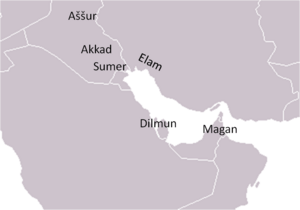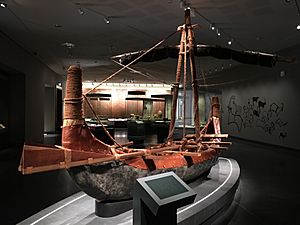Magan (civlization) facts for kids
Magan (also called Makkan) was an important ancient land. It is mentioned in very old writings from around 2300 BC. These writings were made by the Sumerian people using a special script called cuneiform. Magan was a key place for getting valuable materials like copper and a hard stone called diorite. These materials were sent to Mesopotamia, another powerful ancient region, until about 550 BC.
Where Was Magan Located?
Historians and archaeologists are not completely sure where Magan was. Most clues from archaeological digs and geological studies point to Magan being in the area we now call Oman.
However, some experts think Magan might have been in other places. These ideas include the Ma'in region of Yemen, parts of Upper Egypt, Nubia, or even Sudan. Some also suggest it could have been in modern-day Iran or Pakistan. It's a bit of a mystery!
What Did Magan Trade?
Magan was famous for its rich supply of copper. This metal was very important in ancient times for making tools, weapons, and art. Magan also provided diorite, a strong, dark stone used for sculptures and buildings.
For a long time, Magan traded a lot with the city of Ur in Mesopotamia. This trade was especially strong before a group called the Gutian kings took control of Ur.
Trade Routes and History
After the Gutian kings were removed from power, a new ruler named Ur-Nammu came to power in Ur around 2100 BC. He worked to fix the old trade routes. This helped trade between Magan and Ur start up again.
Later on, the trade of copper from Magan changed. When trade with the Indus Valley region slowed down, copper from Magan was replaced. Instead, copper began to be imported from Alashiya, which is what ancient Cyprus was called. This shows how trade routes and sources of materials could change over time in the ancient world.



